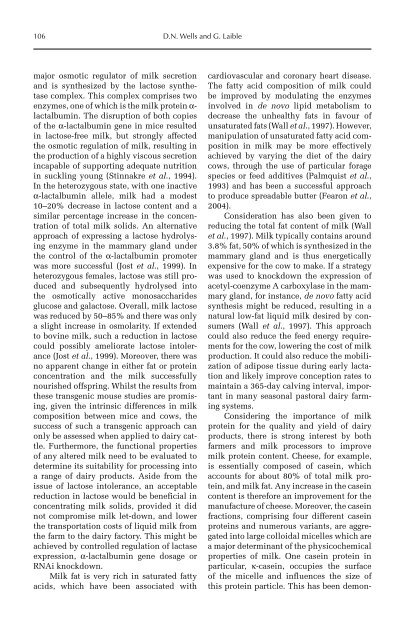Redesigning Animal Agriculture
Redesigning Animal Agriculture
Redesigning Animal Agriculture
Create successful ePaper yourself
Turn your PDF publications into a flip-book with our unique Google optimized e-Paper software.
106 D.N. Wells and G. Laible<br />
major osmotic regulator of milk secretion<br />
and is synthesized by the lactose synthetase<br />
complex. This complex comprises two<br />
enzymes, one of which is the milk protein αlactalbumin.<br />
The disruption of both copies<br />
of the α-lactalbumin gene in mice resulted<br />
in lactose-free milk, but strongly affected<br />
the osmotic regulation of milk, resulting in<br />
the production of a highly viscous secretion<br />
incapable of supporting adequate nutrition<br />
in suckling young (Stinnakre et al., 1994).<br />
In the heterozygous state, with one inactive<br />
α-lactalbumin allele, milk had a modest<br />
10–20% decrease in lactose content and a<br />
similar percentage increase in the concentration<br />
of total milk solids. An alternative<br />
approach of expressing a lactose hydrolysing<br />
enzyme in the mammary gland under<br />
the control of the α-lactalbumin promoter<br />
was more successful (Jost et al., 1999). In<br />
heterozygous females, lactose was still produced<br />
and subsequently hydrolysed into<br />
the osmotically active monosaccharides<br />
glucose and galactose. Overall, milk lactose<br />
was reduced by 50–85% and there was only<br />
a slight increase in osmolarity. If extended<br />
to bovine milk, such a reduction in lactose<br />
could possibly ameliorate lactose intolerance<br />
(Jost et al., 1999). Moreover, there was<br />
no apparent change in either fat or protein<br />
concentration and the milk successfully<br />
nourished offspring. Whilst the results from<br />
these transgenic mouse studies are promising,<br />
given the intrinsic differences in milk<br />
composition between mice and cows, the<br />
success of such a transgenic approach can<br />
only be assessed when applied to dairy cattle.<br />
Furthermore, the functional properties<br />
of any altered milk need to be evaluated to<br />
determine its suitability for processing into<br />
a range of dairy products. Aside from the<br />
issue of lactose intolerance, an acceptable<br />
reduction in lactose would be beneficial in<br />
concentrating milk solids, provided it did<br />
not compromise milk let-down, and lower<br />
the transportation costs of liquid milk from<br />
the farm to the dairy factory. This might be<br />
achieved by controlled regulation of lactase<br />
expression, α-lactalbumin gene dosage or<br />
RNAi knockdown.<br />
Milk fat is very rich in saturated fatty<br />
acids, which have been associated with<br />
cardiovascular and coronary heart disease.<br />
The fatty acid composition of milk could<br />
be improved by modulating the enzymes<br />
involved in de novo lipid metabolism to<br />
decrease the unhealthy fats in favour of<br />
unsaturated fats (Wall et al., 1997). However,<br />
manipulation of unsaturated fatty acid composition<br />
in milk may be more effectively<br />
achieved by varying the diet of the dairy<br />
cows, through the use of particular forage<br />
species or feed additives (Palmquist et al.,<br />
1993) and has been a successful approach<br />
to produce spreadable butter (Fearon et al.,<br />
2004).<br />
Consideration has also been given to<br />
reducing the total fat content of milk (Wall<br />
et al., 1997). Milk typically contains around<br />
3.8% fat, 50% of which is synthesized in the<br />
mammary gland and is thus energe tically<br />
expensive for the cow to make. If a strategy<br />
was used to knockdown the expression of<br />
acetyl-coenzyme A carboxylase in the mammary<br />
gland, for instance, de novo fatty acid<br />
synthesis might be reduced, resulting in a<br />
natural low-fat liquid milk desired by consumers<br />
(Wall et al., 1997). This approach<br />
could also reduce the feed energy requirements<br />
for the cow, lowering the cost of milk<br />
production. It could also reduce the mobilization<br />
of adipose tissue during early lactation<br />
and likely improve conception rates to<br />
maintain a 365-day calving interval, important<br />
in many seasonal pastoral dairy farming<br />
systems.<br />
Considering the importance of milk<br />
protein for the quality and yield of dairy<br />
products, there is strong interest by both<br />
farmers and milk processors to improve<br />
milk protein content. Cheese, for example,<br />
is essentially composed of casein, which<br />
accounts for about 80% of total milk protein,<br />
and milk fat. Any increase in the casein<br />
content is therefore an improvement for the<br />
manufacture of cheese. Moreover, the casein<br />
fractions, comprising four different casein<br />
proteins and numerous variants, are aggregated<br />
into large colloidal micelles which are<br />
a major determinant of the physico chemical<br />
properties of milk. One casein protein in<br />
particular, κ-casein, occupies the surface<br />
of the micelle and influences the size of<br />
this protein particle. This has been demon-










